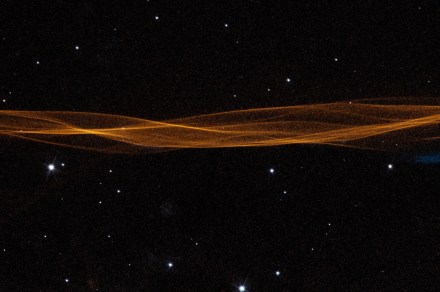Some of the most dramatic events in the universe are the deaths of massive stars. When stars far larger than our sun run out of fuel and explode in huge supernovas, these events not only let out huge blasts of energy but also change the environment around them. As the shockwave from the explosion travels outward millions of miles into space and slams into clouds dust and gas, it can create elaborate and beautiful structures called supernova remnants .
One of the most famous remnants is the Cygnus Loop, a bubble-shaped object which is around 120 light-years across. Hubble imaged the remnant in 2020, and now scientists are using this Hubble data to study how these remnants change over time. Though a doomed star exploded some 20,000 years ago, its tattered remnants continue racing into space at breakneck speeds – and NASA’s Hubble Space Telescope has caught the action.
The nebula, called the Cygnus Loop, forms a bubble-like shape that is about 120 light-years in diameter. The distance to its center is approximately 2,600 light-years. The entire nebula has a width of six full Moons as seen on the sky.
NASA, ESA, Ravi Sankrit (STScI) “Hubble is the only way that we can actually watch what’s happening at the edge of the bubble with such clarity,” said Ravi Sankrit of the Space Telescope Science Institute, lead author of the new research, in a statement . “The Hubble images are spectacular when you look at them in detail. They’re telling us about the density differences encountered by the supernova shocks as they propagate through space, and the turbulence in the regions behind these shocks.
” Recommended Videos The shock is traveling at an incredible speed of over half a million miles per hour, which the researchers could calculate by comparing Hubble observations from 2020 and 2001 to see the shock front expanding over time. The results can be seen in a time-lapse video on the Hubble website. One surprising finding is that the shock hasn’t slowed down at all in this time.
The image looks like a filament because we are seeing it from the side, like a wrinkled sheet, the researchers explain. “You’re seeing ripples in the sheet that is being seen edge-on, so it looks like twisted ribbons of light,” said William Blair of Johns Hopkins University. “Those wiggles arise as the shock wave encounters more or less dense material in the interstellar medium.
” The shape is created by the shock moving through the interstellar medium, which is the thin region of dust and gas between star systems. “When we pointed Hubble at the Cygnus Loop we knew that this was the leading edge of a shock front, which we wanted to study. When we got the initial picture and saw this incredible, delicate ribbon of light, well, that was a bonus.
We didn’t know it was going to resolve that kind of structure,” said Blair. The research is published in The Astrophysical Journal . Editors’ Recommendations See the sparkling Terzan 12 globular cluster in new Hubble image Hubble captures a sparkling cloud galaxy located right next door Clouds on Neptune might be created by the sun, strangely enough James Webb telescope captures the gorgeous Ring Nebula in stunning detail Hubble watches an extreme exoplanet being stripped by its star.
From: digitaltrends
URL: https://www.digitaltrends.com/space/hubble-cygnus-loop-timelapse/
